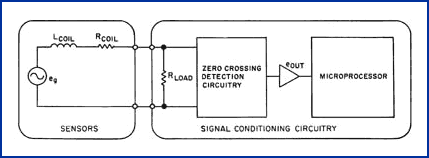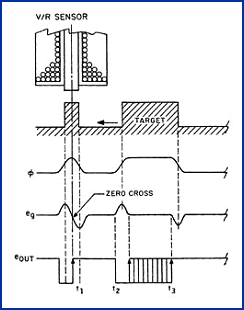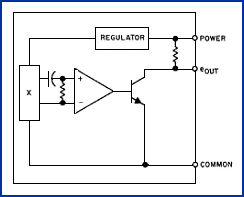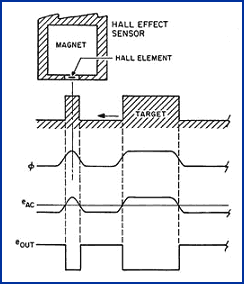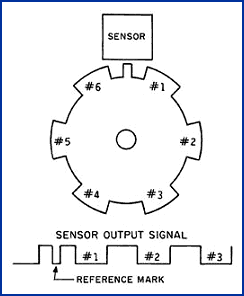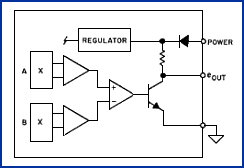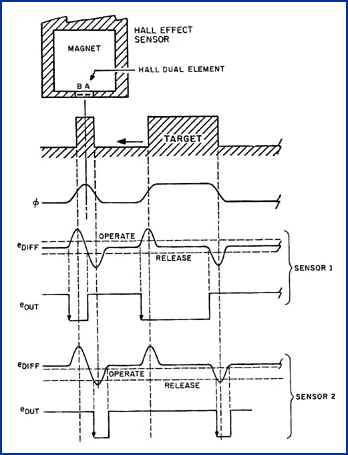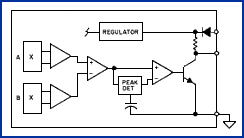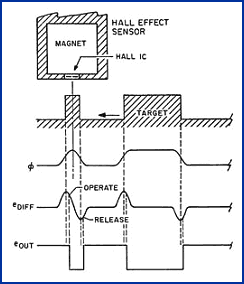Fuel efficiency, emission control, and improved precision in machine control have become high priorities in engineering design. Advanced computers and sophisticated software algorithms are valuable tools, but a computer can perform amazing feats only when it receives accurate feedback from the mechanical system it is trying to control. The objective of a sensing system used in timing applications is to provide an electrical signal that accurately corresponds to the physical object being monitored. Magnetic sensors such as Hall effect and magnetic pickups are candidates for this job. Each, however, must be evaluated for its ability to satisfy the particular requirements of the application.
The four types of sensor discussed in this article are:
- Variable reluctance (V/R) sensors with zero cross detection
- Single-element Hall effect sensors with zero cross detection
- Zero speed, differential Hall effect sensors with offset level detection
- Differential Hall effect sensors with dynamic peak detection
Variable Reluctance
A V/R sensor or "mag pickup" is basically a small generator that produces an analog voltage proportional to the size and speed of a ferromagnetic target passing in front of the sensor. The output voltage has an inherent characteristic that is ideal for certain types of timing applications. The V/R sensor consists of a coil, a pole piece, and a magnet; its equivalent electrical schematic is shown in Figure 1.
|
The open circuit voltage, eg, is proportional to the number of turns of the coil and the rate of change of the magnetic field:
eg = n dF / dt
where:
n = number of turns in the coil dF = rate of change in magnetic flux dt = rate of change in time
Figure 2 illustrates the voltage waveforms generated when a target passes in front of the sensor. The first tooth in the target profile has a width approximately that of the diameter of the sensor pole
|
In the case of the smaller tooth, voltage eg passes through zero at a point that is coincident with the center of the tooth. A digital output signal with a positive transition occurring at this point can be generated using standard zero cross detection circuitry. The wider tooth profile shown in Figure 2, however, has an unpredictable zero cross point that could produce a timing signal occurring at any point between t2 and t3 and therefore would not be suitable for timing applications. This inherent zero cross characteristic of a V/R sensor works well for timing applications as long as the target tooth width is close to the diameter of the sensor pole piece. This ideal timing signal at zero cross occurs only when there is minimal or no electrical load on the sensor. With a resistive load, the inductance of the sensor coil will cause the current in the circuit to lag the open circuit generator voltage and create a phase shift in the output voltage or timing signal:
f = tan-1 [(2pfLCOIL) / (RLOAD + RCOIL)
where:
f = phase shift f = frequency of output signal LCOIL = inductance of sensor coil RLOAD = load resistance RCOIL = resistance of sensor coil
This effect can be minimized by incorporating a signal conditioning circuit that has a relatively high input impedance. Where lower load impedances are required, the phase shift must be compensated in the postprocessing electronics. This is a relatively easy task because the phase shift is proportional to the speed and very predictable. For timing applications where the tooth size can be kept close to that of the sensor pole piece diameter, the V/R sensor is an excellent choice. It is not suitable, however, for applications requiring complex or multiple-width target profiles.
with Zero Cross Detection
This type of sensor produces a digital output signal that closely replicates the target profile. A
|
The Hall effect sensor generates a voltage proportional to the magnetic field flowing through it. As the target passes by the Hall element, the magnetic field through the element will vary in relation to the target profile (see Figure 4). The Hall element will generate a small electrical voltage proportional to the changing flux. This signal is superimposed on the large DC voltage created by the fixed field from the magnet and must be run through a high-pass filter (standard AC coupling) to remove the large DC offset voltage. The resulting signal is a small AC voltage that swings above and below a
|
This type of sensor has a significant advantage in applications where unique target profiles provide different types of positioning information to the computer. For example, a narrow tooth in the target wheel could provide a reference mark for the crankshaft position, and the piston positions could be determined with wider, evenly spaced teeth (see Figure 5). In a V/R sensing system, two sensors and a dual target configuration would be required to obtain the same information.
Zero Speed, Differential Hall EffectSensors with Fixed Operate and
Release Points
|
The signal, eDIFF, is the voltage difference between Hall elements A and B (see Figure 7, below). This voltage is compared to a couple of fixed thresholds that establish the operate and release points of the signal. Notice that sensor 1 in the diagram has operate and release points evenly spaced above and below the nominal differential signal voltage. When eDIFF exceeds the operate point, the digital
|
|
Dynamic Peak-Detecting
Differential Hall Sensors
This type of sensor is based on a dual-element, differential Hall effect technology similar to the zero
|
This technique, relatively new on the market, is inherently well suited for timing applications. The differential voltage eDIFF is the same as with the zero speed, differential Hall sensor but the detection method is not (see Figure 9). Instead of having fixed operate and release points, this sensor is referenced to the peak levels of the incoming signal. The reference points are just below the peak level and are dynamically updated with a track-and-hold circuit. When the input signal level
|
Summary
Understanding the operating principles of the various candidate sensors is an important first step toward selecting the right device for a timing application, but attention must be paid as well to many other considerations such as overall costs, mechanical packaging, installation requirements, and environmental conditions before making the final choice.
